Tested: KTM & Husky’s XC Models
As outlined in the FAQs piece we recently published about KTM and Husqvarna’s cross-country ranges, these non-registrable models sit somewhere between their enduro and motocross cousins, and were introduced primarily for riders in the market for a lightweight, enduro-style competition bike. Their componentry is more closely aligned with the motocross models (they run the MX bikes’ engine, frame, rising-rate linkage, and suspension – including the WP AER air fork), but how do they perform relative to their equivalent-capacity enduro counterparts? How versatile are they in different terrain types? And what are the pros and cons of ownership?
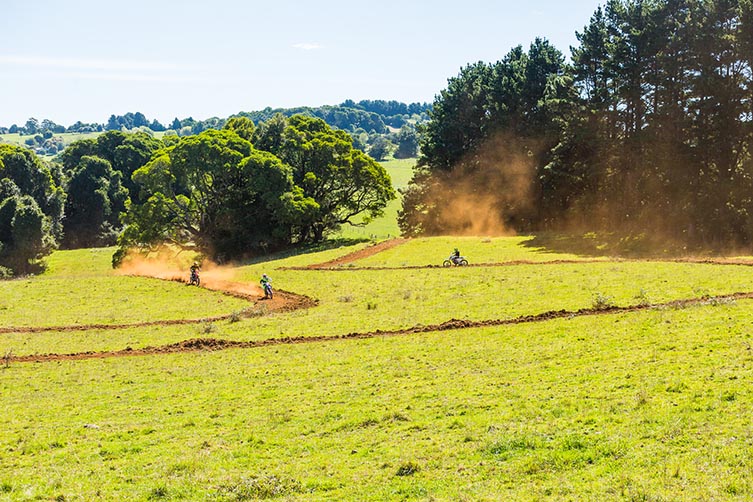
To find out, we assembled a cross-section of test animals – of varying weights, abilities and riding backgrounds – to evaluate KTM’s 300XC two-stroke and Husqvarna’s FX450 four-stroke over a two-month period. And to make sure we got a well-rounded picture of these cross-country bikes, we tested them in everything from the Transmoto 12-Hour’s tight, chopped-out singletrail, to Bundaland’s fast, flowing and loamy grasstrack. Here’s what the boys had to say…
RIDER FEEDBACK…
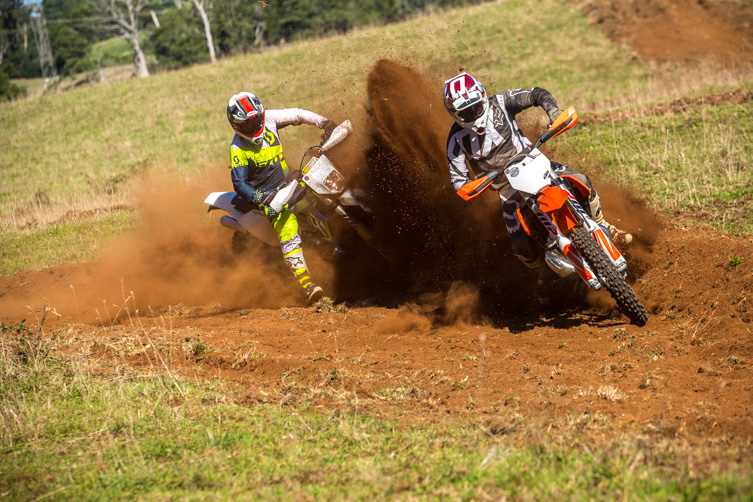
BEN BUNDA – FORMER ENDURO PRO
45, 177CM, 74KG
“These cross-country weapons feel more like motocrossers than enduro models. They’ve got a race-oriented, raw, minimalist feel. They’re noticeably lighter, and their suspension has a firmer overall feel. And because they sit taller in the front-end, they’re stable on fast tracks, but don’t turn as well in tight terrain as enduro bikes, which tend to come with a super-plush fork. Those firmer suspension settings also let you slam square-edged bumps at speed and nail jumps and G-outs with much more confidence.
“But that feedback is all based on the standard suspension settings. And for me, that on-the-spot adjustability – particularly with the air fork – is the standout feature of these cross-country bikes. I’m a lighter rider, so having the ability to let some air out of the fork gave me a level of tunability that I simply couldn’t get from a coil-sprung fork – not without taking it to a suspension tuner to change the spring rates, anyway. I also found that the link-type shocks were very responsive to clicker changes, and had enough of an adjustment range to suit my weight. When I first rode these cross-country bikes at the 12-Hour, I was skeptical about whether they’d have the sort of versatility I like from my bikes. But after playing around with the suspension set-up and getting my head around the different mapping options – which make a big difference to the power delivery – it convinced me that the bike I want to buy is a 250XC. I love the 300XC’s agility, bit it had just a little too much motor for the off-road terrain I like to ride.
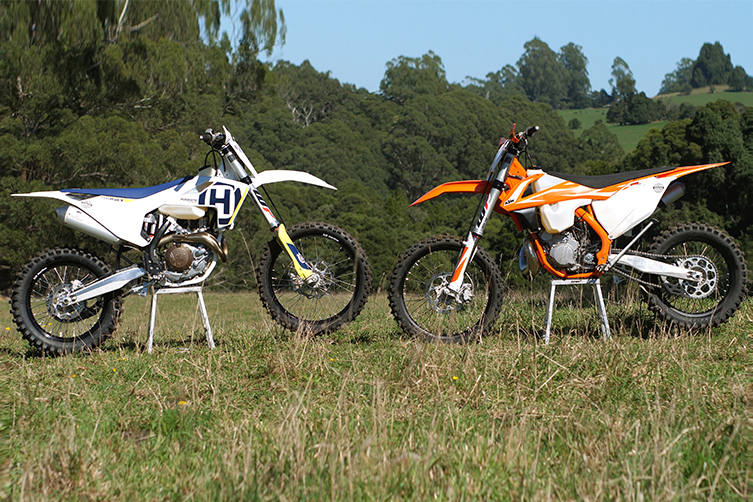
“The power delivery on both cross-country bikes we tested also surprised me. As expected, they both deliver their power more aggressively than equivalent-capacity enduro models, which means you need to be more precise with your throttle application. But the close-ratio six-speed box on the 300XC allowed me to use that power pretty effectively on motocross tracks and in tight bush. On the 12-Hour’s tighter tracks, though, I struggled with the FX450’s five-speed transmission, and I stalled it from flame-outs a few times. It’s just not as forgiving and versatile as the FE450’s power delivery, and you need to be big, fast and strong to properly ride the FX450 off-road. For traditional off-road riders, I think the six-speed FX350 would be a better choice.”
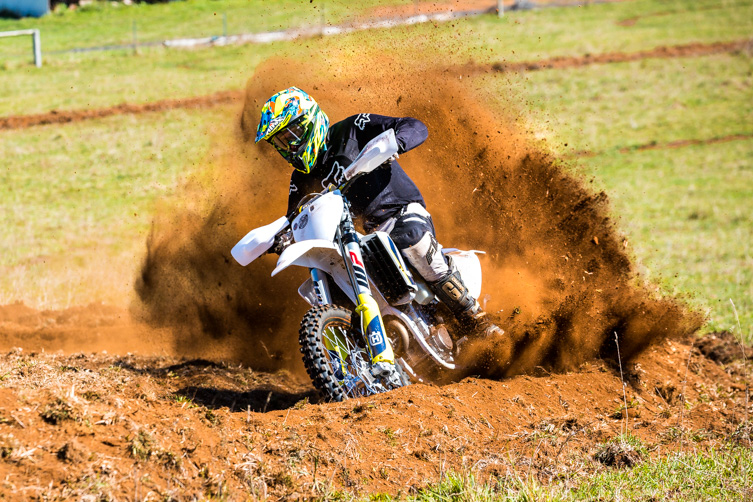
ANDREW HAMILTON – MR All-Rounder
51, 176CM, 68KG
“The first observation I made when I got on these cross-country models is how light they feel to ride, and how similar the ergonomics are to a motocross bike. Even though they share the enduro models’ larger-capacity fuel tanks, the lower bars make you feel like you’re sitting higher and further forward on the bike; in a more aggressive, more commanding, MX-style position. I think the overall performance of the cross-country bikes’ engines and rolling chassis makes them better suited to a more skilled rider. General punters will find the XC bikes’ suspension set-up a little firm, compared with an enduro-spec set-up.
“That said, the cross-country bikes’ adjustability, particularly with the air fork, gives you the ability to make a very quick changes to the bike’s ride. In no time flat, you can adapt it from that Pro rider, MX-bike feel to a much plusher ride that punters will find pretty comfortable in the bush. And it’s really versatile because we managed to get it set up for riders ranging from 65 to 100kg, all without having to pull the fork out and re-valve and/or re-spring it. It’s amazing how quickly you can firm the suspension settings up at both ends and transform the bikes’ ride from plush enduro steads into motocross-style weapons. And the sheer range of adjustment really surprised me.
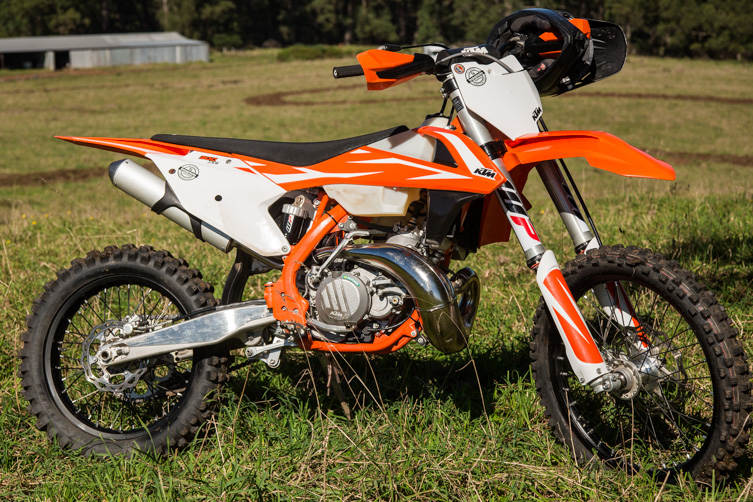
“The motors on both two- and four-stroke cross-country bikes had a noticeably shorter, sharper and more aggressive style of power delivery, which makes them better suited to more experienced riders. But both bikes’ softer ignition/mapping options (and the traction control, in the four-stroke’s case) instantly made them more user-friendly. And there’s a significant difference between the two maps. In other words, they’ve managed to combine motocross and enduro personalities into one bike, and they’ve made it easy to switch between the two.
“All that said, I found that the more aggressively you rode these cross-country models, the better they responded. These bikes are better suited to fast or even Pro-level riders who want to compete on them. If you’re looking for an ‘enduro’ bike to ride a combination of trails and closed-course and public-road enduro, then you’d want to be a competent rider to get the most from these cross-country models. Plus, you’ll need to consider the fact you can’t register them – not until they expand the Rec Rego program beyond Victoria, anyway – and that they’re harder to sell.”
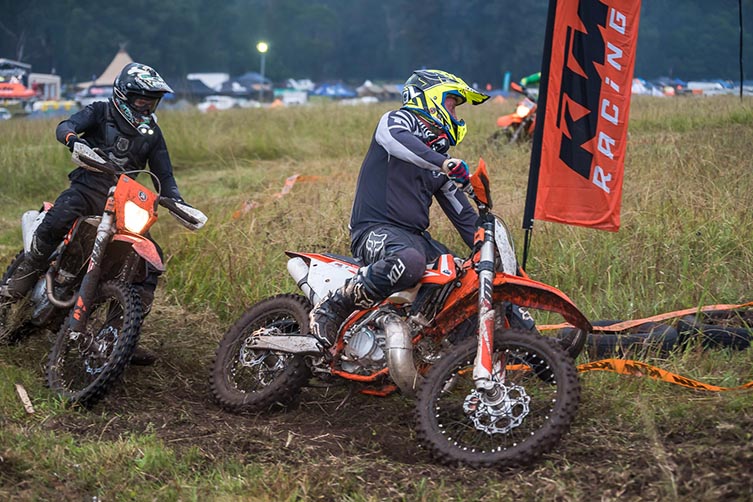
GARETH COOPER – B-GRADE MXER
30, 180CM, 102KG
“The ergos on both cross-country machines made them feel more MX-oriented than I’d expected. They were definitely firmer sprung and lighter to throw around, but the big thing I noticed was how you sat more up on top of the XC models. I didn’t notice a lot of weight difference between the two-stroke cross-country and enduro bikes, but there was night and day between the four-strokes. After stepping off the FX450 and doing a lap on a mate’s stock FE450, the enduro bike felt like I was riding a road train into a corner.
“The thing that really took me by surprise was how well both cross-country models’ suspension worked everywhere. When I mucked around with air pressures in the fork, I found it was really important to get it set up to suit the rider’s weight. When I used the 125-128psi that our lighter testers seemed to like, I got really bad arm pump. But back up at 136-138psi, the fork gave me a sweet ride in technical stuff, and the confidence to hit big shit hard. I mean, I know that the factory KTM team guys, Glenn Kearney and Daniel Milner, set their fastest lap times at the 12-Hour with only 110-115psi in their air fork. But those blokes are race snakes who hardly weigh 100kg between them, whereas I’m more of a fat wombat!
“What I loved most about both cross-country bikes was their snappy, super-responsive power. Coming from a motocross background, I’ve always liked to ride higher in the rev range, and I’m used to that lighter flywheel feel. I ride loose, so I like my bikes to feel tingly and alive and reactive. And that’s why I absolutely loved the power on the 300XC. Admittedly, it was a bit harder to ride toward the end of the 12-Hour, when the track was beat-up and I was tired. With the 300EXC’s broader power, you could pull a taller gear and ride more lazily. And I definitely set faster laps late in the day on the enduro model. With the 300XC, you had to be on your game the entire time. The FX450 is also more aggressive than the 450cc enduro model, but it’s got that much power, you can get away with all sorts of things. With a bit of clutch, it’d still pull hard out of slow corners in third gear.”
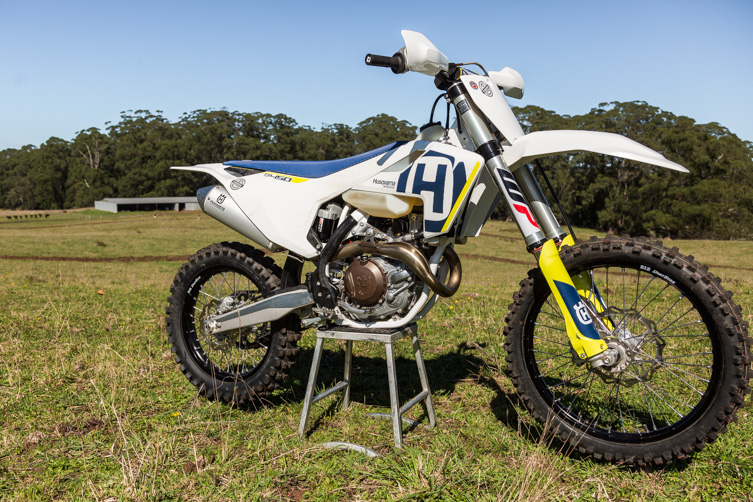
JARRAD DUFFY – ENDURO PUP
21, 187CM, 85KG
“As a taller guy, I noticed that the bars were lower and more swept-back on the cross-country models, which creates a nice aggressive riding position for flat turns, but didn’t feel as comfortable to stand on in the bush or for longer sections of trail. Both cross-country bikes we tested felt lighter than their enduro cousins, but the difference on the four-stroke was most noticeable to me.
“As expected, the cross-country bikes had a firmer, more MX-oriented ride, and I found it interesting that the linkage rear-ends gave me more feel for how the rear wheel was hooking up. Before dropping the air forks’ recommended pressure of 141psi, it felt like the bikes’ front-ends were sitting as if they were running extra spring pre-load, and that made it hard to get enough weight over the front wheel and to get the bikes turning predictably. After experimenting with the air pressure, I ended up at about 135psi. That seemed to create the best front-to-rear chassis balance for my weight. It also made the front-end feel more planted in both the bush and MX track, which gave me a lot more confidence to push harder.
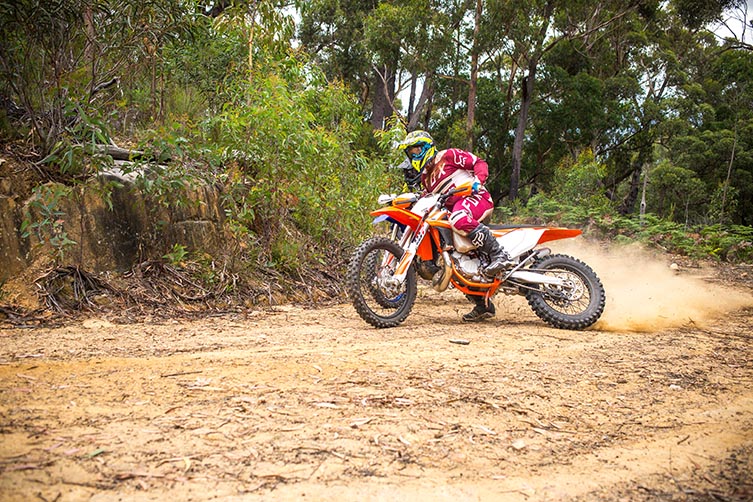
“Power-wise, I really liked the FX450, and it was cool to have the map-switch selector and traction control options. On the standard map, its power was surprisingly linear and tractable for a 450, which made it pretty manageable in the bush. The aggressive map turned the thing into an animal on the grasstrack, where there was plenty of traction. The only issue I had with the FX was stalling it on the slower or technical corners, which I assume had something to do with the mapping and/or tall gearing.
“I found the 300XC’s engine less user-friendly in the bush. It was pretty aggressive and hard-hitting compared with the broad power I’ve gotten used to with the 250 and 300cc enduro bikes from Kato and Husky – which, let’s face it, are as close to a four-stroke as two-strokes get. Without that torquey, responsive, forgiving power at lower revs, the 300XC had to be ridden more like a 250cc MX bike. I mean, it was awesome around the grasstrack, but difficult and tiring to use in tech terrain. It was all or nothing, and that made it harder to find my flow on the 12-Hour’s singletrail, especially when the track got super-bumpy.”
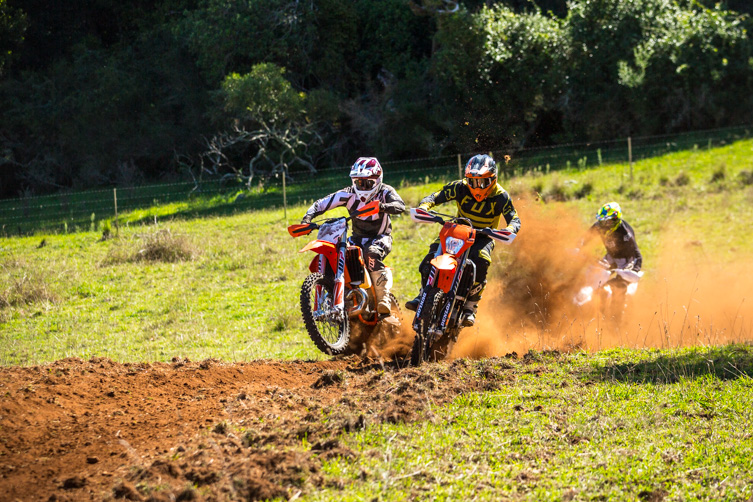
ANDY WIGAN – ENDURO VET
51, 183CM, 87KG
“Before my first hit-out on the cross-country bikes at the Transmoto 12-Hour, I was concerned the combo of stiffer, MX-style suspension and rough, tree-lined singletrack would be a bit sketchy. But after lowering the pressure in the air fork and backing off the compression clickers at both ends, I found that both machines handled surprisingly well. Reducing the air fork’s pressure to 130psi helped rock the chassis forward, and that allowed the bikes to steer quicker in the tight stuff, without compromising stability on the higher-speed grasstrack sections. I also found I could easily bunny-hop the lightweight cross-country machines over the bigger bumps, and change direction really quickly. Admittedly, on the 12-Hour track’s choppy trails and square-edged roots and rocks, the XC models didn’t feel as plush or planted as an enduro bike. But I reckon that was mainly due to their stiffer frames, because the action of the air fork itself was hard to fault. With 125-130psi, it was just as plush as the enduro models’ Xplor fork, but had better more progression and bottoming resistance for jump landings and G-outs.
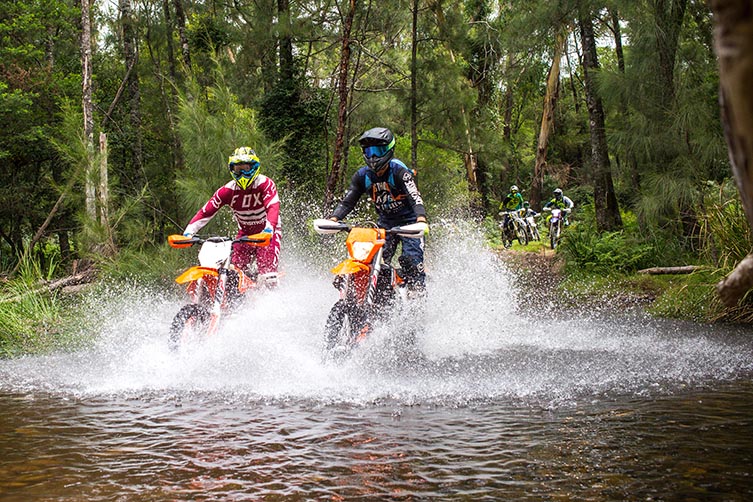
“On the rough 12-Hour track, I struggled to get comfortable with the 300XC and FX450’s punchier style of power. Compared with the 300EXC’s broad and user-friendly power delivery, the lighter flywheel effect of the 300XC’s powerplant made it a handful in technical terrain, and it wore me out quickly. The FX450 was better as you could short-shift it and torque your way around. But the combination of its tall gearing, five-speed MX transmission and harder-hitting power made it more difficult to draw smooth, flowing lines when the going got rough, and it was much easier to stall in slow-speed rutted turns.
“Our previous comparisons of WP’s air- and coil-sprung forks reinforced how big the air fork’s range of adjustment is. But moving from the super-tight 12-Hour loop to the fast and flowing grasstrack at Bundaland really underlined that the air fork lets you alter the both chassis geometry and the fork’s action. You can soften the settings and tip the bike on its nose for off-road use, and then firm the suspension back up again to give it more high-speed stability and bottoming resistance around a motocross track. So, in effect, you get two bikes in one.
“On the face of it, the weight saving and lower price tags do make these cross-country bikes more appealing to trail and/or enduro guys. But the reality is, you need to be a competent rider to pedal one of these machines fast in the bush.”
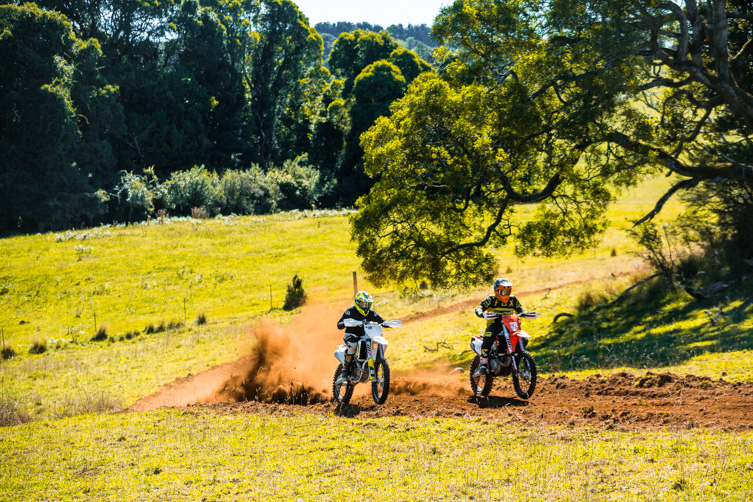
THE VALUE PROPOSITION
If you’re an experienced off-road rider who’s in the market for a lightweight race bike with punchy power delivery, then the new breed of cross-country models from KTM and Husky ought to at least be on your radar – especially as they’re up to $1800 cheaper than their enduro counterparts (check out this comparative RRP tables for both brands here).
Similarly, if you’re a motocross guy who wants a hard-nosed race weapon that you can also take off-road to join your mates for the odd trailride, these cross-country machines offer good value. Unlike the MX models, you get a close-ratio six-speed transmission (except the FX450), extra fuel capacity, an 18-inch rear wheel, a sidestand, and a beefier stator and wiring loom (which gives them the ability to run a headlight) – for which you pay a $500 to $1000 premium, depending on the model.
For average trail/off-road riders, however, the enduro models’ more forgiving engine and suspension package makes them a smarter choice. Not to mention the fact they can be taken off-road legally outside of Victoria, and their resale values are much higher.
In the coming years, when it’s inevitable that fuel injection will be fitted to KTM’s and Husky’s MX and cross-country models, we plan to revisit this comparo. Why? Because we reckon the combination of on-the-spot adjustability for both suspension and power delivery will make these cross-country models even more versatile. And that’s got to make them an appealing proposition for a broader cross-section of riders.
Related Content

🎥 IN-DEPTH: KTM/HUSQVARNA XC MODELS

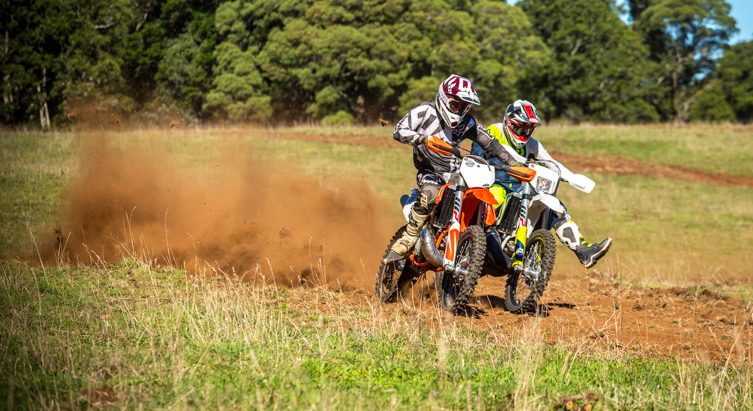


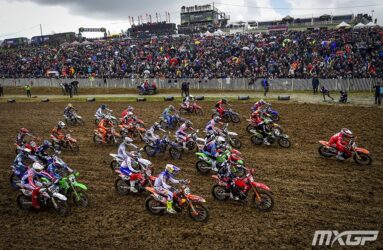


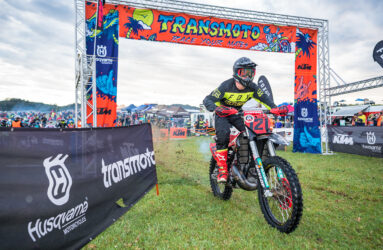


Be the first to comment...